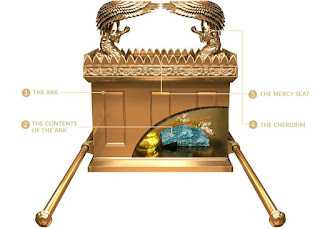THE LIVES OF THE PATRIARCHS #147 | THE LIFE OF MOSES #128
Pastor Christopher Choo
Lesson 3833
THE LIVES OF THE PATRIARCHS #147
THE LIFE OF MOSES #128
MOSES AT MT. SINAI #27
THE TRANSFORMING GLORY OF GOD #11
THE ARK OF THE COVENANT ( Part 3)
THE BACKGROUND OF THE THREE ITEMS IN THE ARK OF THE COVENANT.
Interestingly, the most complete inventory of the contents of the ark of the covenant is found in the New Testament: Hebrews 9:4 says that the Most Holy Place had “the gold-covered ark of the covenant. This ark contained the gold jar of manna, Aaron’s staff that had budded, and the stone tablets of the covenant.” The stone tablets were those on which Moses had written the Ten Commandments.
But how do we reconcile it with the statement in 1 Kings 8:9 that "There was nothing in the ark except vthe two tablets of stone that Moses put there at Horeb, where wthe Lord made a covenant with the people of Israel, when they came out of the land of Egypt." ?
Let us read what the Bible says.
1. The Two Tablets
At various times in Israel’s history, it seems that various items were in the ark of the covenant.
When God first gave Moses the instructions on building the ark, He said, “Put in the ark the tablets of the covenant law, which I will give you” (Exodus 25:16).
2. The Omer of Manna
Sometime during the wilderness wanderings, God commanded that a bowl of manna be added to the ark’s cargo: “Moses said to Aaron, ‘Take a jar and put an omer of manna in it. Then place it before the Lord to be kept for the generations to come.’
As the Lord commanded Moses, Aaron put the manna with the tablets of the covenant law, so that it might be preserved” (Exodus 16:33–34).
3. The Rod of Aaron
After the rebellion of Korah, God commanded the leader of each tribe of Israel to bring a staff to the tabernacle. The name of each leader was inscribed in his staff; the tribe of Levi bore Aaron’s name.
God instructed that the staffs be placed in the tabernacle overnight.
The next morning, Aaron’s rod “had not only sprouted but had budded, blossomed and produced almonds” (Numbers 17:8) as a sign of God’s blessing on the Levitical priesthood.
God then said, “Put back Aaron’s staff in front of the ark of the covenant law, to be kept as a sign to the rebellious” (verse 10).
So, by the time Israel reached the Promised Land, the ark was associated with the items as mentioned in Hebrews 9:4: the stone tablets, the bowl of manna, and the staff of Aaron.
When King Solomon’s temple was finished, the king had the ark of the covenant, along with all the other furnishings of the tabernacle, brought to the new temple’s dedication.
At that time, the biblical historian notes that “there was nothing in the ark except the two stone tablets that Moses had placed in it at Horeb” (1 Kings 8:9; cf. 2 Chronicles 5:10).
Reconciling Hebrews 9:4 with 1 Kings 8:9
There are two possible ways to reconcile 1 Kings 8:9 with Hebrews 9:4.
1. One is that the ark in Moses’ time contained all three items mentioned in Hebrews but, by Solomon’s time hundreds of years later, only the stone tablets remained.
The other items could have been removed in Eli’s time by the men of Beth Shemesh when “they looked into the ark of the Lord” (1 Samuel 6:19).
Before that, the ark was in the possession of the Philistines for a time, and they could have removed some of the ark’s contents.
It could also be that Solomon himself had the manna and the staff removed from the ark and set nearby in the same room at the time of the temple’s dedication.
2. Another possibility is that the bowl of manna and Aaron’s staff were not usually inside the ark of the covenant, but rather beside it.
God’s command in Exodus 16:33 was for Moses to place the manna “before the LORD” (ESV) or “in a sacred place before the LORD” (NLT).
Similarly, the staff was to be placed “before the testimony”
(Numbers 17:10, ESV) or “permanently before the Ark of the Covenant” (NLT).
So, the manna and the staff were kept in the same place as the tablets of stone, but it’s possible they were not, strictly speaking, inside the ark.
It’s also quite possible that the bowl of manna and Aaron’s staff were carried inside the ark every time the ark was moved.
When the ark was at rest in the Most Holy Place, the manna and the staff were placed beside or in front of the ark.
But, while the ark was in transit, the most practical place to carry the manna and the rod was inside the ark.
Whatever the views, this topic has sparked so much controversy in both Judaism and Christianity until now.
Let God's Word in the Book of Revelation have the last and final say:
John wrote in Revelation 11:19 that after the Great White Throne Judgment, “God’s temple in heaven was opened, and the ark of his covenant was seen within his temple.”
At that future time, the veil over the hearts of all Christians, Jews, and Gentiles will be eliminated. This new state of the church will reveal the mysteries of the word and its truths fully illuminated.







